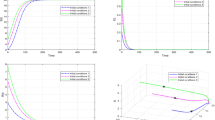Abstract
We present a Susceptible-Infective-Susceptible (S-I-S) model with two distinct discrete time delays representing a period of temporary immunity of newborns and a disease incubation period with randomly fluctuating environment. The stability of the equilibria is robustly investigated for the case with and without delay. Conditions for supercritical and subcritical Hopf bifurcation are derived. Comprehensive numerical simulations show that adding delay to an epidemic model could change the asymptotic stability of the system, altering the location of (stable or unstable) endemic equilibrium, or even leading to chaotic behavior. Further, simulation results illustrate that, in some cases where the disease becomes endemic in the model system without delay, addition of delays for temporary immunity and incubation period facilitates smaller final infective population sizes, even if endemicity is still maintained. Effects of randomness of the environment in terms of white noise are thoroughly investigated jointly with delay. The results demonstrate that there are no significant differences in dynamical behaviour of the system when considering delay solely or jointly with stochasticity.
Similar content being viewed by others
References
Busenberg S., Cooke K. L. and Pozio M. A., Analysis of a Model of a Vertically Transmitted Disease, Journal of Mathematical Biology, 17, 305–329, (1983)
Franke J. E. and Yakubu A. A., Discrete-time SIS epidemic model in a seasonal environment, SIAM Journal on Applied Mathematics, 66(5), 1563–1587, (2006)
Hassard B. D., Kazarinoff N. D. and Wan Y. H., Theory and Applications of Hopf Bifurcation. Cambridge University Press, Cambridge, England, (1981)
Hethcote H. W., Wang W., Han L. and Ma Z., A predator-prey model with infected prey, Theor. Popul. Biol., 66, 259–268, (2004)
Hofbauer J. and Sigmund K., The Theory of Evolution and Dynamical System. Cambridge University Press, Cambridge, (1998)
Hsieh Y. H. and Hsiao C. K., Predator-prey Model with Disease Infection in Both Populations, Mathematical Medicine and Biology, 25(3), 247–266, (2008)
Marsden J. E. and McCracken M., The Hopf bifurcation and its Applications. Springer-Verlag, New York, (1976)
Nisbet R. M. and Gurney W. S. C., Modelling Fluctuating Populations, Wiley-Interscience, (1982)
Woods C. R., Syphilis in children: congenital and Acquired. Seminars in Pediatric Infectious Diseases, 16, 245–257, (2005)
Author information
Authors and Affiliations
Corresponding author
Additional information
This paper was written partially while the first author was in China Medical University as a Post-doctoral Fellow.
Rights and permissions
About this article
Cite this article
Das, P., Mukandavire, Z., Chiyaka, C. et al. Bifurcation and chaos in S-I-S epidemic model. Differ Equ Dyn Syst 17, 393–417 (2009). https://doi.org/10.1007/s12591-009-0028-4
Published:
Issue Date:
DOI: https://doi.org/10.1007/s12591-009-0028-4




